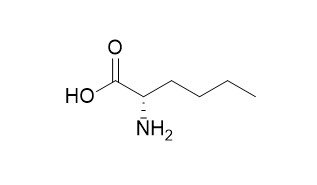L-Norleucine
The unbranched norleucine residue has intermediate properties for -structure formation.
Inquire / Order:
manager@chemfaces.com
Technical Inquiries:
service@chemfaces.com
Tel:
+86-27-84237783
Fax:
+86-27-84254680
Address:
1 Building, No. 83, CheCheng Rd., Wuhan Economic and Technological Development Zone, Wuhan, Hubei 430056, PRC
Providing storage is as stated on the product vial and the vial is kept tightly sealed, the product can be stored for up to
24 months(2-8C).
Wherever possible, you should prepare and use solutions on the same day. However, if you need to make up stock solutions in advance, we recommend that you store the solution as aliquots in tightly sealed vials at -20C. Generally, these will be useable for up to two weeks. Before use, and prior to opening the vial we recommend that you allow your product to equilibrate to room temperature for at least 1 hour.
Need more advice on solubility, usage and handling? Please email to: service@chemfaces.com
The packaging of the product may have turned upside down during transportation, resulting in the natural compounds adhering to the neck or cap of the vial. take the vial out of its packaging and gently shake to let the compounds fall to the bottom of the vial. for liquid products, centrifuge at 200-500 RPM to gather the liquid at the bottom of the vial. try to avoid loss or contamination during handling.
Theranostics.2023, 13(9):3103-3116.
Journal of Third Military Medical University2019, 41(2):110-115
Sci Rep.2023, 13(1):13610.
Pharmaceutics.2022, 14(5):945.
Int J Mol Sci.2024, 25(15):8101.
Fitoterapia.2018, 124:92-102
Korean J. Crop Sci.2018, 63(2):131-139
Industrial Crops and Products2022, 188:115638
Molecules.2023, 28(8):3376.
Food Sci Biotechnol.2023, 32(7):997-1003.
Related and Featured Products
Biopolymers, 2010, 16(8):1815-1826.
Conformational properties of L ‐leucine, L ‐isoleucine, and L ‐norleucine side chains in L ‐lysine copolymers.[Reference:
WebLink]
METHODS AND RESULTS:
The structure inducing properties of L-leucine, L-isoleucine, and L-Norleucine residues incorporated into poly(L-lysine) were investigated by the observation of the circular dichroism of the respective random copolypeptides. The comparison involves the coil-helix transition in water/methanol mixtures, the formation of ordered structures at higher pH, and the kinetics of the -helix to -conformation transition of the leucine and norleucine copolymers induced by temperature changes at pH 10.5.
CONCLUSIONS:
The results confirm the known properties of the leucine residue, strongly supporting the -helix conformation. They also support the idea that the isoleucine residue is one of the most powerful candidates for -structure formation, and they show that the unbranched norleucine residue has intermediate properties. The results are discussed on the basis of steric and hydrophobic properties of the three side chains.



